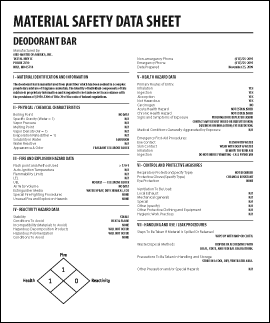UPDATE: See From MSDS to SDS (Safety Data Sheets)
A Material Safety Data Sheet — MSDS — is designed to tell you everything you need to know to use a chemical safely. Although there are many different types of MSDS, each must include the eight parts listed below.

Chemical Name
- the name on the label
- date the MSDS was prepared
- name and address of the manufacturer
- phone number for emergencies
Hazardous Ingredients / Chemical Identity
- names of dangerous substances in the chemical
- safe exposure limits such as PEL (Permissible Exposure Limit) or TVL (Threshold Value Limit)
- common names for the chemical
Physical Characteristics
- how it looks and smells
- boiling and melting temperatures
- evaporation rate (percent volatile)
- how easily it dissolves
- how heavy it is — so you know whether it will sink, float or dissolve in water
Fire and Explosion Data
- the “flash point” — the lowest temperature in which it could catch fire
- whether it is flammable or combustible
- the best way to put out a fire involving the chemical
Reactivity
- conditions that can cause it to burn, explode or release dangerous vapors
- substances that react with it
Health Hazards
- the dangers of inhaling or touching it
- first aid procedures
- dangers for people with medical conditions
Usage, Handling and Storage
- how to clean up a spill or leak
- how to handle, store and dispose of the chemical
Special Protection and Precautions
- personal protective equipment that should be used
- other equipment for working with the chemical
- special procedures
- signs that might be posted
- information not covered in other sections
Always read the MSDS before working with any chemical!
Note: Not only should workers use the MSDS to protect themselves from injury, but it could greatly affect insurance claims in the event of injury. Insurance companies may examine the MSDS of any product that was involved in an accident. If the worker was found negligent in their use of the appropriate personal protective equipment (PPE), as outlined in the MSDS, and injured by the product, they may receive substantially lower disability payments.
